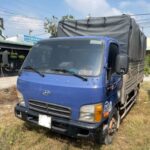Truck blind spots are a hidden danger for both drivers and pedestrians. So, where are truck blind spots and how can you identify and avoid them? This article will provide detailed information about truck blind spots, helping you travel more safely on the road.
Truck Blind Spots – Dangerous Areas
Truck blind spots are areas around the vehicle that the driver cannot see directly or through the rearview mirrors. The larger the truck, the wider the blind spots. Blind spots not only make it difficult for drivers to maneuver, especially when turning, reversing, or making U-turns, but also pose a risk of collisions and serious traffic accidents. Many factors contribute to blind spots, such as vehicle design, driver’s height and seating position, and rearview mirror adjustment.
Truck blind spot zones from different angles
Critical Truck Blind Spots to Be Aware Of
1. Blind Spot in Front of the Truck
Large trucks and specialized vehicles often have high cabins that obstruct the driver’s view of the area directly in front of the vehicle. This is the front blind spot. To ensure safety, avoid moving too close to the front of a truck, overtaking from the front, and especially cutting in front of a truck. Trucks are heavy and difficult to brake suddenly to avoid collisions.
2. Blind Spots on Both Sides of the Truck
The space on both sides of the truck that is not reflected by the rearview mirrors is the side blind spot. To identify it, look at the truck’s rearview mirror. If you can see the driver, the driver can also see you. Conversely, if you cannot see the driver, you are in the blind spot and need to move out of this area quickly. Avoid driving parallel to or close to the side of a truck.
Car positioned in the side blind spot of a truck.
3. Blind Spot Behind the Truck
The rear blind spot is the area hidden behind the rear of the truck or cargo bed, which can extend from a few meters to about 60 meters from the rear of the vehicle. In this area, the driver cannot see any objects or pedestrians at all. Conversely, pedestrians in this area are also blocked from view. This is the most dangerous blind spot, posing a high risk of accidents when the driver is reversing, braking suddenly, parking, or driving in crowded areas.
4. Other Blind Spots on Trucks
In addition to the 3 main blind spots above, there are other blind spots with smaller ranges, such as those caused by the A-pillar, below the rearview mirrors, on the roof, and under the undercarriage. Drivers and pedestrians still need to be aware of these.
How to Overcome Truck Blind Spots for Drivers
Adjust Rearview Mirrors Correctly
To minimize side blind spots, drivers should lean their head to each side until it touches the window glass, then adjust the mirror so that the side of the vehicle is almost no longer in the reflection. Observe with the naked eye when changing lanes or turning.
Adjust Driver’s Seat and Seating Position
Adjust the driver’s seat so that the eye level is higher than the steering wheel and directly above the middle of the windshield. The seating position must be convenient for observing the rearview mirrors on both sides without moving too much.
Equip Multi-Directional Mirrors
Many current truck models are equipped with a full mirror system to help drivers observe in multiple directions and reduce blind spots.
Multi-directional mirror system on a truck to reduce blind spots.
If the standard mirror system is not optimal, you can buy additional auxiliary mirrors or choose larger mirrors at authorized service stations or reputable truck parts suppliers.
Conclusion
Understanding where truck blind spots are and how to overcome them will help both drivers and other road users avoid accidents. Always pay attention to observation, maintain a safe distance from trucks, and obey traffic laws to ensure safety for yourself and the community.
